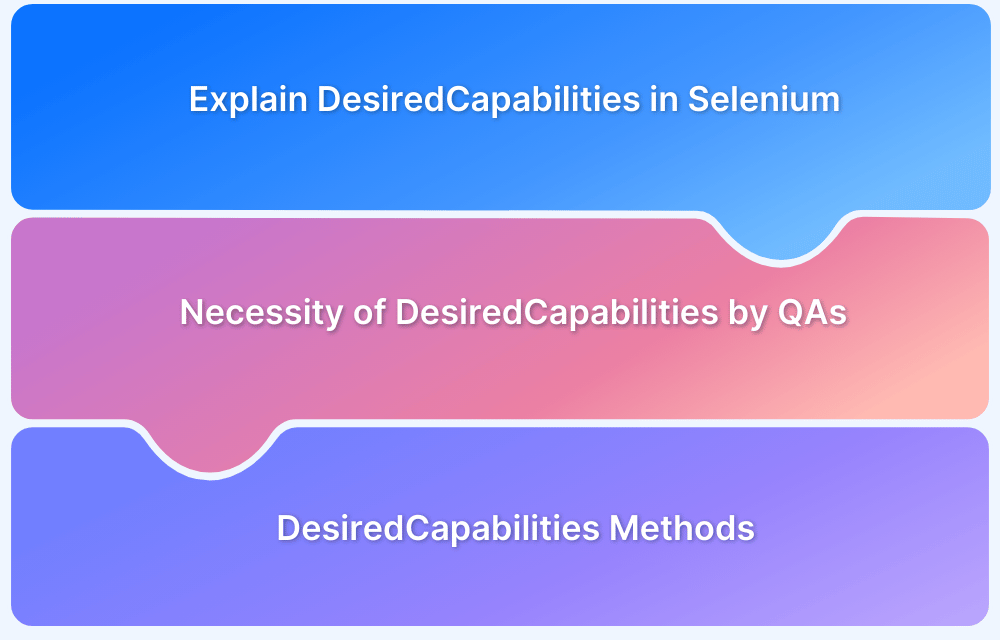When testing web applications, refreshing a page is a routine yet essential task. While reloading data, validating session persistence, or checking dynamic content updates, page refreshes often play an important role in browser automation. Selenium WebDriver is a popular tool for browser automation as it offers multiple methods to achieve page refresh.
Overview
Scenarios for Refreshing a Page
- Keeping Data Fresh and Accurate
- Maintaining User Sessions
- Handling Cached Content Efficiently
- Recovering from Unexpected Errors
- Debugging and Troubleshooting Issues
5 Ways to Refresh a Page using Selenium WebDriver
- Using driver.navigate().refresh()
- Using get() with the Current URL
- Using sendKeys() with F5 Key
- Using JavaScript Executor
- Using Browser Back and Forward Navigation
Common Challenges while Refreshing a Page and How to Handle Them
- StaleElementReferenceException
- Timing Issues
- Session Expiry
- Browser Compatibility
- Unexpected Popups and Alerts
This guide outlines the use cases, methods, challenges, and best practices for refreshing a page using Selenium WebDriver.
Scenarios for Refreshing a Page
Refreshing web page is a common practice in browser automation and manual testing. It helps ensure that web applications function correctly and provide a smooth user experience across various scenarios. Some important scenarios where refreshing a page is important include:
1. Keeping Data Fresh and Accurate
Imagine you’re tracking live updates, such as stock prices or real-time notifications. A page refresh helps confirm that newly loaded or updated data is displayed correctly without users needing to manually refresh the page. Refreshing a page in this scenario ensures that:
- Dynamic content such as dashboards, tables, and charts are updating as expected.
- No stale or outdated information persists after a refresh.
- Data retrieved from the backend is reflected accurately in the UI.
2. Maintaining User Sessions
Users expect a seamless experience when navigating web applications, even after page reload. Testing session continuity ensures that users don’t lose their login status, preferences, or ongoing tasks when they refresh the page. Refreshing a page in this scenario helps verify that:
- Authentication tokens or cookies persist correctly.
- User-specific settings (like language or theme preferences) remain intact.
- Forms or workflows in progress do not get reset unexpectedly.
3. Handling Cached Content Efficiently
Browsers often store elements of a website to speed up load times, but sometimes this may lead to outdated content being displayed. Testing cache management via a page refresh ensures that users always see the latest version of the page, especially when updates are pushed. Refreshing a page in this scenario helps check:
- Browser correctly fetches fresh content instead of using cached resources.
- If the application implements proper cache-control policies.
- Effectiveness of cache-busting techniques to prevent stale data issues.
Read More: How to handle Cookies in Selenium WebDriver
4. Recovering from Unexpected Errors
Web apps can occasionally run into glitches, such as UI freezes, unresponsive elements, partial loading failures, etc. A page refresh can be used as recovery mechanism to help users get back on track. Refreshing a page in this scenario can help:
- Resolve temporary API failures or UI rendering issues.
- Restore broken page components that failed due to intermittent connectivity.
- Ensure the error-handling mechanisms guide users effectively after a reload.
5. Debugging and Troubleshooting Issues
When things go wrong, such as slow page loading or missing elements, a simple page refresh can provide valuable insights. Developers and testers often rely on refreshes to diagnose and replicate issues effectively. With the help of browser developer tools, refreshing a page in this scenario can:
- Identify performance bottlenecks by analyzing network requests and loading sequences.
- Help reproduce UI glitches for debugging purposes.
- Validate if intermittent issues reoccur after a reload, aiding in root cause analysis.
Read More: How to check Website Loading Time
5 Ways to Refresh a Page using Selenium WebDriver
Selenium WebDriver offers multiple methods to refresh a page for different testing scenarios. Below are five most commonly used ways:
1. Using driver.navigate().refresh()
This method is the simplest and most direct way to refresh a page. It tells WebDriver to reload the current webpage. You can use this method when you need a straightforward page refresh without altering the browser’s history.
WebDriver driver = new ChromeDriver();
driver.get("https://browserstack.com");
driver.navigate().refresh();
driver.quit();2. Using get() with the Current URL
This method reloads the page by re-fetching its URL. It’s equivalent to typing the URL into the browser’s address bar and pressing Enter. You can use this method for scenarios where re-initialization of the current state is required.
WebDriver driver = new ChromeDriver();
driver.get("https://browserstack.com");
driver.get(driver.getCurrentUrl());
driver.quit();3. Using sendKeys() with F5 Key
This method simulates pressing the F5 key on the keyboard to refresh the page. It relies on the sendKeys() function to perform the action. You can when testing keyboard shortcuts or mimicking user actions.
WebDriver driver = new ChromeDriver();
driver.get("https://browserstack.com");
new Actions(driver).sendKeys(Keys.F5).perform();
driver.quit();4. Using JavaScript Executor
The JavaScript Executor allows you to run custom JavaScript commands to refresh the page. The location.reload() function is commonly used for this purpose. This method is best suited for refreshing pages in scenarios where JavaScript interactions are required.
WebDriver driver = new ChromeDriver();
driver.get("https://browserstack.com");
((JavascriptExecutor) driver).executeScript("location.reload()");
driver.quit();Read More: Desired Capabilities in Selenium Webdriver
5. Using Browser Back and Forward Navigation
This method refreshes the page by navigating back and forward in the browser. It’s similar to manually clicking the back and forward buttons to reload the current state. You can use this method when you need to reset the page without directly reloading the URL.
WebDriver driver = new ChromeDriver();
driver.get("https://browserstack.com");
driver.navigate().back();
driver.navigate().forward();
driver.quit();Common Challenges while Refreshing a Page and how to handle them
Refreshing a web page during automation or manual testing can sometimes introduce challenges that might impact the results. Here are some common issues you might face and simple ways to fix them:
Sometimes elements become stale after a refresh, causing interactions to fail. This usually happens when elements are dynamically loaded and their references change after a page reload.
To fix this, we can use try-catch blocks to handle the exception and re-locate elements after refresh using driver.findElement() again.
- Timing Issues
Some elements may take longer to reload, leading to intermittent failures. Page load time can vary based on network speed, server response time, and browser performance.
To fix this, we can implement explicit waits using WebDriverWait and ExpectedConditions to ensure elements are available before interacting with them.
WebDriverWait wait = new WebDriverWait(driver, Duration.ofSeconds(10));
wait.until(ExpectedConditions.visibilityOfElementLocated(By.id("elementId")));- Session Expiry:
In some web apps, user sessions may expire during a refresh, leading to unexpected logouts and requiring re-authentication.
To fix this, we can implement session persistence by storing and restoring cookies.
Set<Cookie> cookies = driver.manage().getCookies();
driver.manage().deleteAllCookies();
for (Cookie cookie : cookies) {
driver.manage().addCookie(cookie);
}
driver.navigate().refresh();Different web browsers handle page refresh actions differently, which may lead to inconsistent behaviour, such as differences in cache handling and event triggering.
To fix this, ensure thorough cross-browser testing using tools like BrowserStack Automate to verify refresh functionality across various platforms.
- Unexpected Popups and Alerts
Some pages might display unexpected popups during refresh, such as confirmation dialogs, this may disrupt the test flow.
To fix this, handle popups using Selenium’s Alert class to dismiss or accept them.
Alert alert = driver.switchTo().alert(); alert.dismiss(); // or alert.accept();
Importance of Testing Page Refresh on Different Browsers
As mentioned earlier, page refresh behaviour can vary across different browsers due to differences in caching mechanisms, rendering engines, and event handling. What works smoothly in one browser may lead to unexpected issues in another. This is why cross-browser testing is important to ensure consistent performance and functionality.
For example, Chrome might cache more aggressively than Firefox, leading to scenarios where a page refresh does not fetch the latest data. Similarly, Microsoft Edge might show additional security prompts when refreshing a page. Without thorough testing, these variations can cause automation scripts to behave inconsistently on different web browsers.
To overcome such challenges, BrowserStack Automate offers a cloud-based solution that allows you to run your Selenium scripts on real browsers across multiple devices and platforms. With
BrowserStack Automate, you can:
- Test page refresh actions on different operating systems such as Windows, macOS, Linux, Android, iOS, etc.
- Identify browser-specific refresh issues quickly.
- Run parallel tests to save time and ensure efficient coverage.
- Validate how page refresh impacts performance across various screen sizes and resolutions.
- Ensure compatibility with different network conditions to see how refresh behaves under slow or unstable connections.
Conclusion
Refreshing a web page is an important part of web automation testing, especially when dealing with dynamic content, stale elements, or performance checks. Selenium WebDriver provides multiple ways to perform this task effectively.
But in most scenarios, simply refreshing a page is not enough. You also need to test how it behaves across different browsers and devices. Each browser handles page refreshes differently, which can lead to unexpected issues if not tested properly. That’s why using tools like BrowserStack Automate can be crucial. It allows you to test the effectiveness of page refresh methods on different real browsers and devices, ensuring your automation scripts work consistently everywhere.







